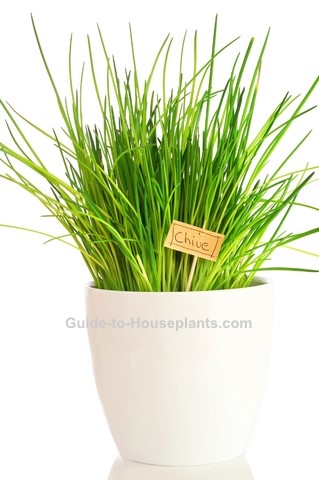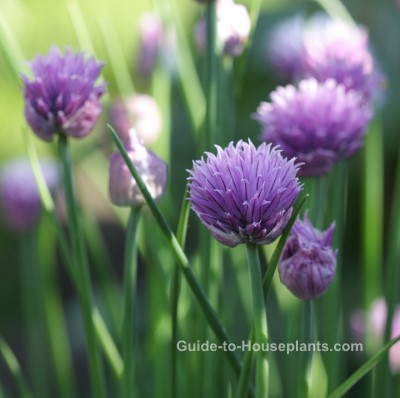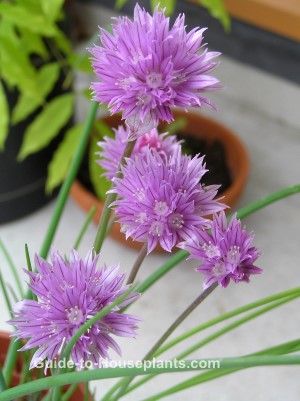Growing Chives Indoors
Growing chives indoors allows you to have a ready supply of this culinary herb year-round. Here you'll discover tips for planting, growing and harvesting chives plant in a pot, plus how much water, light and fertilizer they want.

Get to Know Chives Plant
Known botanically as Allium schoenoprasum, chive herb is a hardy perennial. Its slender, hallow leaves grow in clumps that can reach about 6-12 inches (15-30 cm) tall.
Chives flower in late spring, with round pink to purple blooms appearing atop the leaves.
Growing chives indoors on a sunny windowsill is an easy way to keep it within reach for cooking. Don't have a sunny window for it? Herbs grow wonderfully under artificial grow lights.
Did you know...
Among the first to discover the virtues of this herb are the Chinese, who have been growing chives since 3000 B.C.

Varieties of Chives
Of the common chives (A. schoenoprasum), there are a few named varieties. 'Grolau' is especially suitable for growing indoors.
Garlic chives (A. tuberosum), also known as Chinese chives, have flat leaves with a zesty, garlicy flavor and aroma. It blooms in summer with white, star-shaped flowers. Garlic chive plants are robust in both flavor and growing habit. They spread and drop seeds aggressively, but that's only a concern if you are growing chives plant in the garden.
Harvesting, Using and Preserving Chive Herbs
Harvest Chives Tip
Once the plants bloom, the leaves will start to shrivel and turn yellow. Unless you plan to use the flowers, harvest the leaves steadily to prevent flowering.
How to harvest chives: You can harvest leaves anytime you want when plants reach 6 in (15 cm) tall. Cut leaves off, leaving at least 2 inches of growth above the soil. The leaves as well as the flowers can be used for cooking.
Cooking with chives: Chives are best used fresh. Harvest leaves as needed and chop them with a sharp knife to prevent a stringy texture. They lend a mild onion flavor to meals. Sprinkle chopped chives on potatoes, soups, cheese spreads, stir-fries and other savory dishes. Add whole leaves or flowers to soups and salads for colorful garnishes.
Drying chives takes away most of their flavor, but is an easy way to preserve them. Here's how to dry chives: Cut off leaves, chop, and allow them to dry naturally in a dry, dark place. It should only take a couple days or so...they're "done" when they're crispy.

Tips for Growing Chives Indoors
Light: Give your chive plant at least 6 hours of direct sun per day to help it grow lush and full. Turn plant for even growth because it will tend to grow toward the light source. If you can't put your herbs in a sunny window, growing chives under indoor plant lights works beautifully. Keep the light 6 in (15 cm) above the plant and leave it on for 14 hours a day. This is the equivalent of 6 hours of sun.
Water: Keep soil evenly moist. Leaf tips will turn yellow if plant is too dry.
Humidity: Average room (around 40% relative humidity).
Temperature: Average room temperatures (65-75°F/18-24°C). If you move your pot of chives outdoors for the summer, don't worry -- it can take the heat. However, it won't tolerate frost.
Soil: Good-quality all-purpose potting mix.
Fertilizer: Feed spring through fall with herb fertilizer.
Propagation: Seeds or division. Sow seeds indoors in late winter, covering seeds lightly with potting mix. Keep it moist. Divide established clumps every 2-3 years and pot in fresh potting mix.


